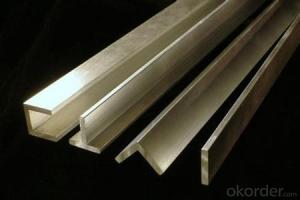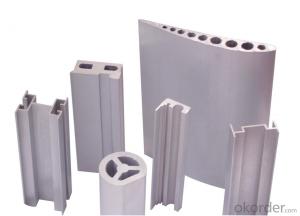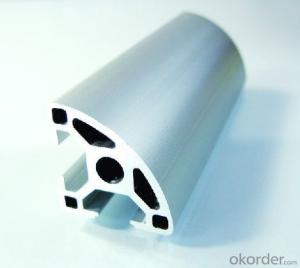various surface treatment industrial aluminium profile extrusion
OKorder Service Pledge
OKorder Financial Service
You Might Also Like
Aluminium is a relatively soft, durable, lightweight, ductileand malleablemetalwith appearance ranging from silvery to dull gray, depending on the surfaceroughness. It is nonmagnetic and does not easily ignite. A fresh film ofaluminium serves as a good reflector (approximately 92%) of visible lightand an excellent reflector (as much as 98%) of medium and far infraredradiation. The yield strength of pure aluminium is 7–11 MPa,while aluminium alloys have yield strengths ranging from200 MPa to 600 MPa. Aluminium has about one-third the densityand stiffness of steel. It is easily machined,cast, drawn and extruded.
Features:
Material | Alloy 6063,6061,6005or according to customer’s choice |
Temper | T3, T4, T5, T6 |
Surface | Anodize, electrophoresis, powder coating, PVDF coating, wood grain painting, matted, etc. |
Length | Coating 6.5 meters, Anodizing 6.5 meters, Mill finish 5 meters |
Application | Industrial, electrical equipment(TV set, air conditioner, refrigerator, computer), decoration,construction, transportation |
Custom Made | We can package following with customer's request. |
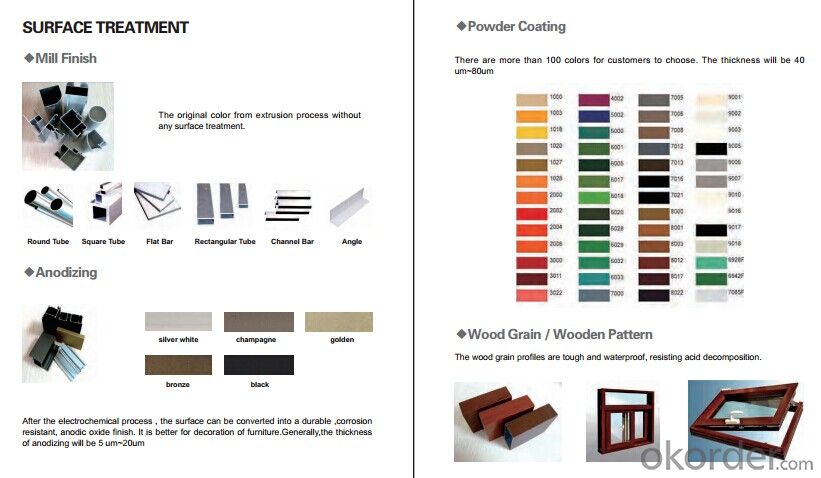

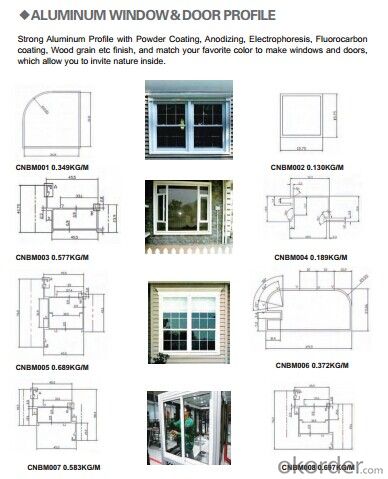
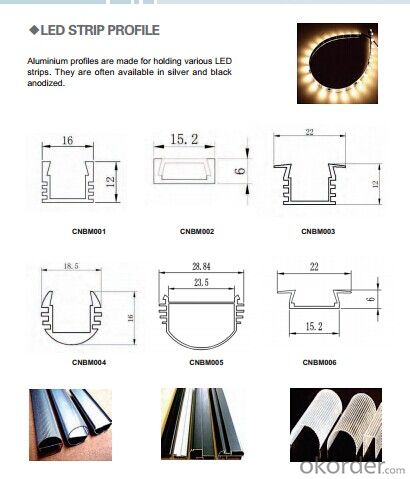
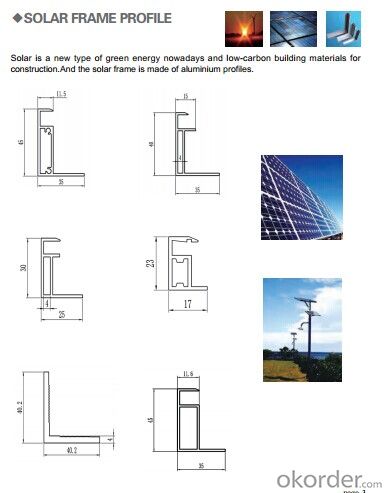
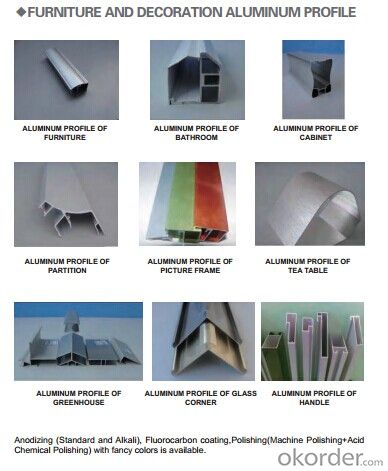
- Q:I want to make my aluminum oxide, how much money is needed is a set of equipment? Please leave, thank you!
- Aluminum oxide brand and aluminum panel process and process, please
- Q:Can aluminum profiles be used in the production of agricultural equipment?
- Aluminum profiles have the potential to be utilized in the manufacturing of agricultural equipment. The versatility and lightweight characteristics of aluminum provide numerous benefits for agricultural applications. Its resistance to corrosion is crucial when considering equipment that is exposed to outdoor conditions and various farming chemicals. Moreover, aluminum profiles have the capability to be easily molded and customized to meet specific design requirements, enabling the creation of intricate and functional agricultural equipment. The lightweight nature of aluminum also simplifies the transportation and handling of the equipment, resulting in reduced labor costs. Additionally, aluminum profiles are recyclable, making them an environmentally conscious choice for the production of agricultural equipment. In conclusion, incorporating aluminum profiles into agricultural equipment can enhance durability, efficiency, and sustainability within the farming industry.
- Q:What are the different shapes available in aluminum profiles?
- Aluminum profiles come in a variety of shapes, each serving specific purposes and meeting different structural requirements. Some commonly used shapes include: 1. T-shape: With a horizontal and vertical section, this profile is ideal for creating joints, connections, or support structures. 2. U-shape: Featuring two parallel sides and an open bottom, this profile is commonly used for framing, edging, or as a protective barrier. 3. L-shape: With one longer side and one shorter side, this profile is frequently used for corner brackets, supports, or right-angle connections. 4. Square shape: With equal sides, square profiles are versatile and can be used for a wide range of applications, such as framing, rails, or supports. 5. Round shape: With a circular cross-section, this profile is perfect for applications that require rounded edges or a seamless look, often used for handrails, decorative purposes, or in the automotive industry. 6. Rectangular shape: With two longer sides and two shorter sides, rectangular profiles are often utilized for structural framing, supports, or as beams. 7. I-beam shape: Also known as an H-beam, this profile has a central vertical web and two horizontal flanges, offering excellent strength and commonly used in construction, bridges, or industrial applications. 8. Channel shape: With a U-shaped cross-section and one side shorter than the other, this profile is widely used for structural support, framing, or as tracks for sliding doors and windows. These examples showcase the variety of shapes available in aluminum profiles. The choice of shape depends on specific project requirements, such as load-bearing capacity, design aesthetics, or functionality.
- Q:How to calculate the spraying powder of aluminium profile?
- Ask not detailed, do not know what you want to ask is how?
- Q:Can aluminum profiles be used for creating lighting fixtures?
- Yes, aluminum profiles can be used for creating lighting fixtures. Aluminum is a popular material choice for lighting fixtures due to its lightweight nature, durability, and corrosion resistance. It is also easily shaped and machined, making it suitable for creating various designs and styles of lighting fixtures. Additionally, aluminum profiles can be powder-coated or anodized to enhance their appearance and provide additional protection against wear and tear. The versatility and aesthetic appeal of aluminum make it an ideal choice for creating lighting fixtures in a wide range of settings, including residential, commercial, and industrial applications.
- Q:How do aluminum profiles provide structural stability?
- Aluminum profiles provide structural stability through their inherent properties and design characteristics. Firstly, aluminum is a lightweight yet strong material, making it ideal for constructing various structures. Its high strength-to-weight ratio means that it can support heavy loads while minimizing the overall weight of the structure. Additionally, aluminum profiles can be designed with various shapes and cross-sections, allowing for optimal load distribution and structural integrity. These profiles can be extruded into different shapes, such as I-beams, T-sections, or rectangular profiles, which can provide enhanced strength and rigidity to the structure. Moreover, aluminum has excellent corrosion resistance, which ensures that the profiles remain durable and structurally sound even in harsh environments. This resistance to corrosion eliminates the need for frequent maintenance and extends the lifespan of the structure. Furthermore, aluminum profiles can be easily fabricated and assembled, allowing for efficient and cost-effective construction. They can be cut, drilled, welded, or fastened together to create complex structures with precise dimensions. This flexibility in fabrication and assembly ensures that the profiles can be tailored to meet specific design requirements and provide optimal structural stability. In conclusion, aluminum profiles provide structural stability through their lightweight yet strong nature, versatile design options, corrosion resistance, and ease of fabrication and assembly. These properties make aluminum profiles a preferred choice in various industries, including construction, transportation, aerospace, and many others.
- Q:What does aluminum T1.5 mean?
- Aluminum should be referred to the thickness of 1.5MM thick.
- Q:Can aluminum profiles be used in HVAC system manufacturing?
- Aluminum profiles are indeed applicable in the manufacturing of HVAC systems. Their lightweight nature, durability, and exceptional thermal conductivity make them highly suitable for HVAC applications. These profiles can be utilized in constructing various components such as air ducts and heat exchangers. Their corrosion resistance is also vital for ensuring the longevity and effectiveness of HVAC systems. Moreover, working with aluminum profiles is effortless, enabling customization and flexibility in the design and construction of HVAC systems. In conclusion, the numerous advantageous properties of aluminum profiles make them a favored option in the manufacturing of HVAC systems.
- Q:Are aluminum profiles resistant to mold or mildew?
- Indeed, aluminum profiles exhibit a remarkable resistance to the growth of mold and mildew. This is due to the inherent properties of aluminum, which render it highly impervious to these unsightly invaders. In contrast to materials like wood, which are susceptible to moisture damage and consequently encourage the proliferation of mold and mildew, aluminum remains unaffected by such issues. Moreover, aluminum profiles are frequently treated with protective coatings or finishes that further bolster their resilience against the encroachment of mold and mildew. Consequently, aluminum profiles represent an ideal choice for areas that are prone to excessive humidity or moisture, such as bathrooms or kitchens, where the growth of mold and mildew is a prevalent concern.
- Q:What is the limitation of aluminum bending
- General extrusion of aluminum quality is soft, over a period of time will be hardened, the longer the material more hard, no impact on the stretch bending, with hydraulic bending machine, there will be no cracks. Dongguan Sheng Hui Machinery Co., Ltd. to serve you. Thanks for taking it
1. Manufacturer Overview |
|
|---|---|
| Location | |
| Year Established | |
| Annual Output Value | |
| Main Markets | |
| Company Certifications | |
2. Manufacturer Certificates |
|
|---|---|
| a) Certification Name | |
| Range | |
| Reference | |
| Validity Period | |
3. Manufacturer Capability |
|
|---|---|
| a)Trade Capacity | |
| Nearest Port | |
| Export Percentage | |
| No.of Employees in Trade Department | |
| Language Spoken: | |
| b)Factory Information | |
| Factory Size: | |
| No. of Production Lines | |
| Contract Manufacturing | |
| Product Price Range | |
Send your message to us
various surface treatment industrial aluminium profile extrusion
OKorder Service Pledge
OKorder Financial Service
Similar products
New products
Hot products
Related keywords

